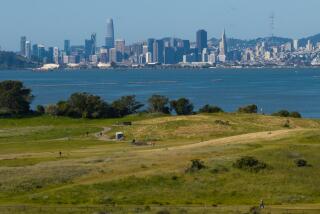Backers of septic ban rode wave of surfers’ testimony
One after another, surfers young and older trooped to the microphone to recount their encounters with the polluted waves off Malibu’s Surfrider Beach.
They told of bouts of diarrhea, conjunctivitis that wouldn’t heal and heart-damaging Coxsackie B4 virus. Some talked of inhaling the pervasive Malibu stench and watching raw sewage pour through the city’s streets and parking lots.
In the end, the testimony of the surfers helped carry the day Thursday for supporters of a ban on new septic systems in the vibrant commercial heart of one of Southern California’s most exclusive enclaves.
Under the prohibition, no new septic systems will be allowed and owners of existing commercial and residential systems will have to halt discharges within the next decade.
Given that Malibu formed its own city government in 1991 to avoid what it viewed as a scheme by Los Angeles County to install sewers and unleash a wave of development, the decision Thursday marked a turning of the tide.
The years-long battle over water quality in Malibu has been a strange collision of slow-growth advocates who viewed septic tanks and leach pits as a check against rapid development and surfers and environmentalists who contended the systems were fouling the city’s groundwater and, by extension, Malibu Creek, Malibu Lagoon and Santa Monica Bay.
In the opinion of many, Malibu dragged its feet for so long that regional water quality officials had no choice but to impose a moratorium.
“The city is recalcitrant still,” surfer Joe Melchione said. “Their record of compliance is abysmal.”
Malibu is a city that wears its green credentials on its Hawaiian shirt sleeves, but its environmental reputation has taken a beating the last several years. Its watershed is considered tainted, and its most popular beach often gets an F on the annual Heal the Bay report card. Researcher after researcher has blamed stressed septic tanks and leaking leach fields as a leading cause of water pollution.
Nonetheless, the septic moratorium did not sit well with many residents and business owners who attended the Los Angeles Regional Water Quality Control Board meeting in downtown Los Angeles. Architect Mike Barsocchini, whose Malibu Knolls neighborhood is affected by the ban, faulted it as an “iron fist” approach in a situation that called for a “velvet glove.”
Residents who use existing septic systems in Malibu Knolls, Serra Retreat and Malibu Colony will have until 2019 to hook into a central wastewater treatment system or otherwise comply with the mandate. The Civic Center commercial area must comply by 2015.
The city projects that homeowners in the moratorium zone would pay about $500 a month for centralized wastewater treatment. Businesses would pay $6,800 to $17,000 a month, depending on the amount of wastewater produced.
Proud of their pristine canyons and gorgeous stretch of coast, Malibu residents have grown accustomed to pumping septic tanks and hiring waste-haulers, even as federal, state and local water quality officials pushed, prodded and nudged the city to figure out how to clean up the pollution.
“The lack of adequate sanitation is a basic public nuisance issue,” said Madelyn Glickfeld, a water board member who lives in Point Dume. “Here we are in one of the richest cities in the U.S., and we have sewage running down the street.”
Until the vote was taken, Malibu had hoped to avoid the prohibition. In testimony, Malibu would not even concede that septic systems were a major cause of pollution; U.S. Geological Service and UCLA scientists testified that fresh samplings of water along the coast suggest that bacteria spikes appeared to be unrelated to on-site wastewater treatment systems.
The city had proposed a phased wastewater treatment plan, with no septic moratorium, for the Civic Center area and Serra Retreat. Under that plan, Malibu Colony homes and two commercial zones on Pacific Coast Highway east of Malibu Creek would have been required to install disinfection equipment on their existing septic systems.
The board found that plan inadequate.
“It has been many, many, many years that they were supposed to be on the path to making this happen,” water board chairwoman Mary Ann Lutz said Friday.
Lutz expressed compassion for residents and business owners who have invested in their personal state-of-the-art wastewater treatment systems. Rick Margolis, who needed five years to obtain permits to build a house in the moratorium zone, said he is spending $150,000 for such a system.
“Now you’re telling us that’s for nothing,” he said. “It’s just a fairness issue.”
Lutz said the city was to blame.”I’m grateful they built the good systems, but many of them shouldn’t have had to spend that money. There should have been a system in place,” she said. “The city should have been ahead of the game or alerting them. The city took no steps toward ensuring the infrastructure would be there.”
Malibu City Manager Jim Thorsen said Friday that he was disappointed by the water board decision and found flaws in the moratorium.
“If we can’t disperse it in the ground, we’re limited in our ability to build a treatment plant,” he said.
For now, he said, the city will focus on whether it should “make a concerted effort” to get the state water board to reject the moratorium.
Glickfeld, the board member who lives in Point Dume, said Malibu should focus on figuring out how to recycle water for irrigation and other uses.
“With water use and costs so high, they’re going to need it here,” she said. “I’m like a doctor, telling Malibu: ‘Take this, it’s good for you.’ ”
--
More to Read
Sign up for Essential California
The most important California stories and recommendations in your inbox every morning.
You may occasionally receive promotional content from the Los Angeles Times.










